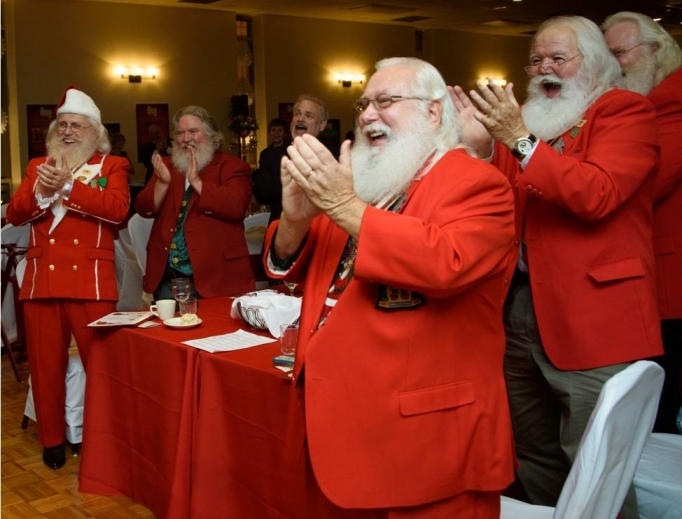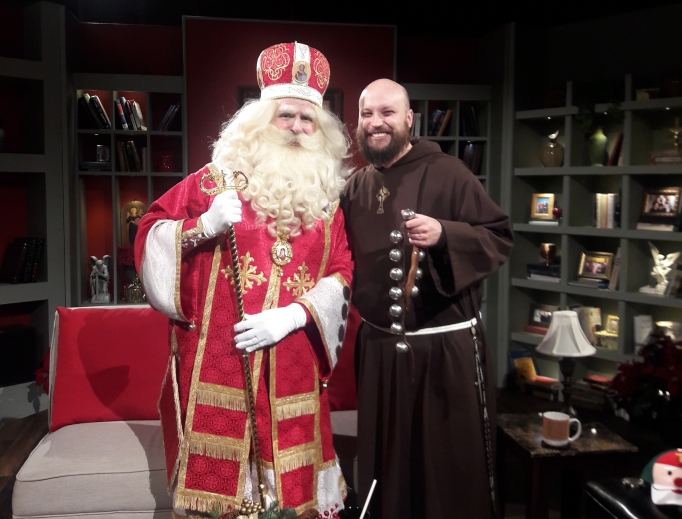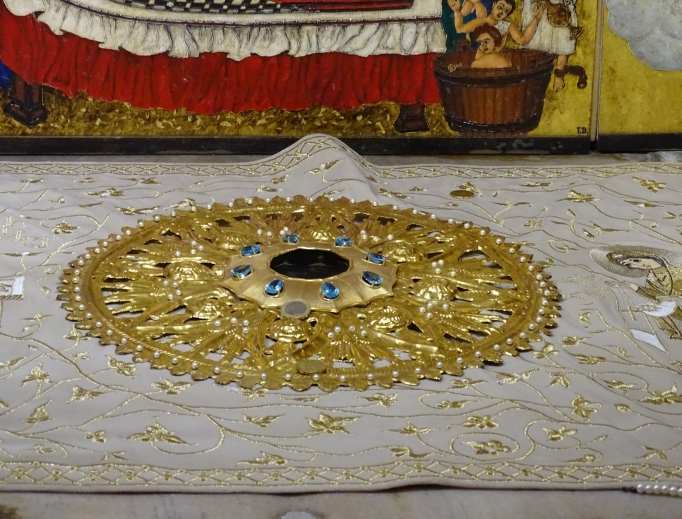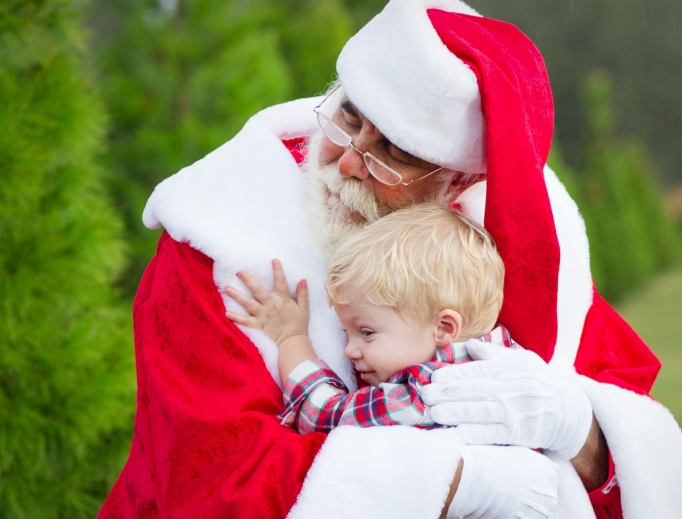Holy Jolliness: ‘Santa School’ Offers Training in Tradition of St. Nicholas
Impersonators are inspired by saintly legacy at the St. Nicholas Institute.

Playing Santa Claus is ho-ho-holy business at the St. Nicholas Institute, where Santas and Mrs. Clauses from across the country and Canada gather annually to be inspired by St. Nicholas’ example.
The one-of-a-kind October retreat and seminar at the St. Paul Retreat Center in Detroit rekindles friendships and includes prayer and learning over three days. Attendees are open to the very spirit that animated the saint whose heart was made glad by the Christ Child.

Jolly applause breaks out at the St. Nicholas Institute’s awards banquet
In story books, Santa lives at the North Pole, but St. Nicholas — the saintly template for Santa — was a real-life Catholic bishop born during the third century in present-day Turkey. He came to be known as Santa Claus from the name Sinter Klaas, which the Dutch called their favorite saint, St. Nicholas.
Although his reputation has been blurred with Christmas-themed associations like a workshop, elves and flying reindeer, he is in fact a saint who died on Dec. 6, 345, at the age of 75. And he still inspires the joy of giving.
A lifelong devotion to St. Nicholas inspired Father Joseph Marquis in 2012 to found the St. Nicholas Institute. He is pastor of Sacred Heart Byzantine Catholic Church in Livonia, Michigan, and has played Santa for 47 years. Father Marquis was inducted into the International Santa Claus Hall of Fame in 2011, was Detroit’s Thanksgiving Day Parade Santa from 1977 through 1989, appeared on TV shows as both Santa and St. Nicholas, including EWTN’s Living Right With Dr. Ray and At Home With Jim and Joy, and even won an Emmy Award for his appearance in a television special with the Four Tops singing group. He also created, co-wrote, illustrated and portrayed St. Nicholas in Saint to Santa: How St. Nicholas Became Santa.
Childhood Devotion
Father Marquis’ own devotion to St. Nicholas began at the age of 6, when he and his twin brother, Richard, fervently prayed to the saint when their mother was hospitalized with a high-risk pregnancy and their father was in a sanitorium suffering from tuberculosis. Despite their grim prognoses, both parents returned home in good health.
Father Marquis has grown ever closer to St. Nicholas — he has five of his relics at All Saints Shrine housed in his parish church, and he has visited the St. Nicholas Shrine in Bari, Italy. It was Pope Benedict XVI’s call to evangelize that inspired Father Marquis to spread Christianity through Santa. “I realized that most people don’t have a clue about him,” he said. “I thought, ‘Wouldn’t it be nice if we could reclaim St. Nicholas?’”
Through the institute, he introduces St. Nicholas to the wider culture. Educational programs for school groups and other audiences are part of the mission. Participation is open to all Christian denominations, but acceptance as a full member requires four years of enrollment and a commitment to embody the spirit of St. Nicholas, even if those participating only want to learn how to be an elf (the school trains mostly Santas and a few Mrs. Clauses and elves).

St. Nicholas, as portrayed by Father Joseph Marquis, visits with Franciscan Father John Paul Mary during a taping of a Christmas special at EWTN.

St. Nicholas’ tomb, from which the superior of the Dominican friars siphons liquid ‘Manna of St. Nicholas’ each May 9, is seen in Bari, Italy.

. A St. Nicholas ‘helper’ and Father Marquis (r) pose in front of the Basilica of St. Nicholas in Bari May 9, 2018.
About St. Nicholas
After his wealthy Christian parents died in an epidemic while he was still young, Nicholas used his inheritance to give to the poor, Father Marquis explained. Inspired by teachings in the New Testament, such as the rich man, who wanted to know how to get into heaven, and Matthew 6:3, about giving in secret and not letting the left hand know what the right hand is doing, Nicholas began secretly giving to the poor, often under cover of night.
“He focused on the dignity of the person, but addressed their profound need,” Father Marquis said. “Nicholas was the first known philanthropist. He was later ordained to the priesthood and became a bishop. He suffered persecution under the Roman Emperor Diocletian and was thrown into prison.”
When Constantine rose to power, persecution ended, and Nicholas was freed. He was present at the Council of Nicaea in A.D. 325, where a basic statement of faith came together in the Nicene Creed. “When the body of St. Nicholas was exhumed in 1953, it appeared that some of his bones had been broken,” Father Marquis said. “His nose was asymmetrical, looking like someone had sucker-punched him. Of the 318 bishops present at the Council of Nicaea, only 11 did not have scars from their imprisonment during the persecution.”
Baptist Meets St. Nick
Although Protestant denominations do not usually honor saints, Adam English, a Baptist and chair of the Department of Christian studies and professor of theology and philosophy at Campbell University Divinity School in North Carolina, is a member and annual speaker at the institute.
He wrote the book The Saint Who Would Be Santa Claus: The True Life and Trials of Nicholas of Myra, for which he received the St. Nicholas Institute’s “Spirit of St. Nicholas Award” in 2013.
Since St. Nicholas was so often described as a legendary figure, English wanted to research the true story for himself. “I got a research grant and traveled to Italy and discovered the historical St. Nicholas is buried in a town named Bari,” English said. “Attached to the basilica is an archived library. It has a treasure trove of documents in Greek and Latin that I was able to translate.”
English discovered a man committed to social justice. “There was an instance when Nicholas intervened during a time of famine and negotiated with a couple of ships passing through the territory for grain for the city,” English said. “He also intervened with a judge and stopped the beheading of three innocent men. Another time, he intervened for the sake of the city to get taxes on grain lowered.”
While researching St. Nicholas, English discovered a whole world of Santas.
“Pretty much every major metropolitan area has some association or group of Santas, but the Institute of St. Nicholas is unique,” he said. “It combines the professional interest of playing Santa with this wonderful spirituality of Jesus but also of St. Nicholas. It’s purely unique. They have a holy jolliness. It shows that we can be committed to faith and the Gospel and do it with joy and silliness.”
Portraying a Saint
Keith Carson (just call him Kriss Kringle) has a ring tone of sleigh bells and is one of the institute’s many members who enthusiastically epitomizes the mission.
He is a Santa from Boynton Beach, Florida, with his own-grown beard, who founded the organization Believe in Santa Foundation: Claus for a Cause.
He makes visits year-round to children of servicemen and women and those suffering from poverty, crime, hospitalization and terminal illnesses, and he has also worked with the Red Cross, especially during the hurricane season. “We bring gifts, pose for photos and spend quality time with the children to try and brighten their lives,” Carson said. A police officer for 25 years, Carson has had training in hospice, psychological first aid and Santa training from various schools. He has attended the St. Nicholas Institute for four years and now also dresses as St. Nicholas to gives talks at schools and churches.
“Attending the institute is one of the most rewarding experiences in my life, for so many reasons — the spirituality, the calm — it recharges my batteries for the season,” he said. “The most important thing is learning the history of St. Nicholas and understanding how he became Santa Claus.”

Keith Carson lives the mission of the St. Nicholas Institute in his portrayal of Santa, complete with his own-grown beard.
Patti Armstrong writes from North Dakota.
INFORMATION
StNicholasInstitute.org
- Keywords:
- christmas
- patti armstrong
- santa
- st. nicholas


















